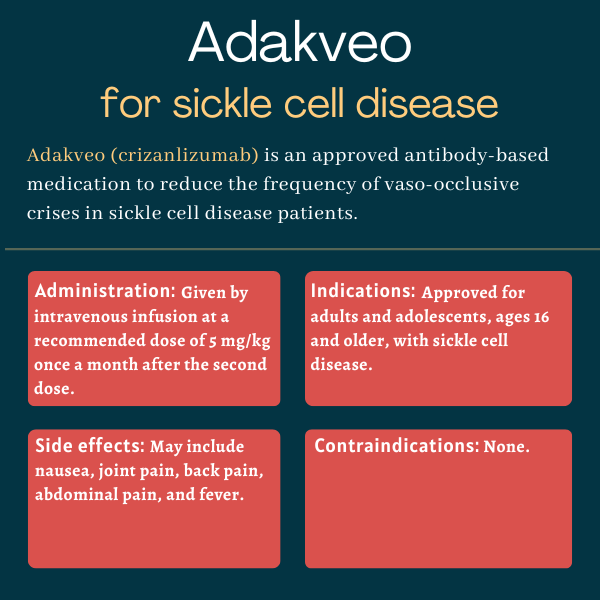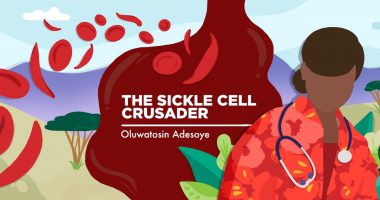Adakveo (crizanlizumab-tmca) for sickle cell disease
Last updated June 20, 2024, by Margarida Maia, PhD

What is Adakveo for sickle cell disease?
Adakveo (crizanlizumab-tmca), formerly known as SEG101 or SelG1, is an antibody-based medication approved for use in adults and adolescents, ages 16 and older, who experience vaso-occlusive crises (VOCs) caused by sickle cell disease (SCD).
Given as an intravenous (into-the-vein) infusion, Adakveo is designed to reduce how often these painful crises happen. It was first developed by Reprixys Pharmaceuticals and acquired in 2016 by Novartis.
Therapy snapshot
| Brand name: | Adakveo |
| Chemical name: | Crizanlizumab |
| Usage: | Used to reduce the frequency of vaso-occlusive crises in patients with sickle cell disease |
| Administration: | Intravenous infusion |
How does Adakveo work?
In SCD, red blood cells become rigid and take on a sickle-like shape that causes them to be more prone to clumping and sticking to the lining of blood vessels. Sickle-shaped red blood cells cannot move easily through blood vessels, and they can block blood flow to tissues and organs. As a result, patients experience a broad range of disease symptoms, including frequent episodes of acute pain known as VOCs. These painful crises are the main reason why patients seek medical care in hospitals.
P-selectin is a protein found on the surface of the endothelial cells that line the inner walls of blood vessels. During inflammation, P-selection traps circulating white blood cells, slowing them down and making them roll along blood vessel walls to help in the immune response. But P-selectin is overproduced on the surface of endothelial cells and clot-forming platelets in SCD patients. Along with white blood cells, sickle-shaped red blood cells also get trapped by P-selectin, causing them to become stuck within blood vessels.
Adakveo contains crizanlizumab, a recombinant, or lab-made, antibody that binds to P-selectin and prevents it from interacting with blood cells, including sickle-shaped red blood cells. Treatment with Adakveo is expected to reduce the frequency of VOCs that occur when blood flow is obstructed by clusters of misshapen blood cells.
Who can take Adakveo?
Adakveo was approved in the U.S. in November 2019 to reduce the frequency of VOCs in adults and adolescents with SCD, ages 16 and older. With this decision, Adakveo became the first approved targeted therapy that specifically works by binding to P-selectin.
It was approved for the same indication in Australia in 2021.
Who should not take Adakveo?
There are no contraindications for the use of Adakveo in SCD patients.
The safety and efficacy of Adakveo in patients younger than age 16 have not been established.
How is Adakveo administered?
Adakveo is available as single-use vials containing 10 milliliters (mL) of a clear to opalescent solution that may be colorless or have a slightly brownish-yellow tint. Prior to infusion, a healthcare professional is to dilute the treatment in a solution containing 0.9% of sodium chloride or 5% dextrose to a total volume of 100 mL.
Adakveo is administered directly into the bloodstream as a 30-minute infusion that should be given by a healthcare professional. The recommended dose is 5 milligrams per kilogram of body weight (mg/kg), given once a month after the second dose. The first and second doses are given two weeks apart.
If a dose is missed, Adakveo should be administered as soon as possible. Dosing should continue as prescribed if the therapy is administered within two weeks of the missed dose. In cases where Adakveo is administered more than two weeks after the missed dose, dosing should be resumed every four weeks thereafter.
Adakveo may be given with or without hydroxyurea, an oral therapy approved to reduce the frequency of VOCs in SCD patients.

Adakveo in clinical trials
Adakveo’s approval in the U.S. was based on data from the Phase 2 SUSTAIN (NCT01895361) clinical trial that evaluated its safety and efficacy in people with SCD with a history of VOCs.
SUSTAIN trial
SUSTAIN enrolled 198 adults and adolescents, ages 16 to 63, who had experienced two to 10 VOCs in the previous year. Those on a stable dose of hydroxyurea were allowed to continue with that treatment.
Patients were randomly assigned to receive a low dose (2.5 mg/kg) or a high dose (5 mg/kg) of Adakveo, or a placebo, as an intravenous infusion over a one-year period. The first two doses were given every other week, while subsequent doses were given every month.
The trial’s main goal was to evaluate the impact of treatment on the frequency of annual VOCs requiring a healthcare visit.
Patients treated with Adakveo at high dose experienced fewer VOCs leading to a healthcare visit and requiring treatment with opioids or nonsteroidal anti-inflammatory drugs (NSAIDs) compared with those on a placebo (median annual rate of 1.63 vs. 2.98). Over one-third of patients (36%) who received the higher dose of Adakveo did not experience any VOCs during the year of treatment. Among those treated at low dose or given the placebo, the median annual VOCs rate was 18% and 17%, respectively.
Treatment with high-dose Adakveo also delayed the median time to a first VOC after starting treatment compared with a placebo (4.07 vs. 1.38 months), as well as the time to a second pain crisis (10.32 vs. 5.09 months).
A post-hoc analysis of trial data that focused on patients who had a high number of VOCs in the year before the trial found they were more likely to become free of these crises than those given a placebo.
STAND trial
A Phase 3 clinical trial called STAND (NCT03814746) is testing the safety and efficacy of Adakveo at the now-approved 5 mg/kg dose and at a higher dose of 7.5 mg/kg, both against a placebo, in more than 250 adults and adolescents, ages 12 and older, with SCD.
After one year of treatment, neither dose outperformed a placebo at reducing the annual rate of VOCs requiring a healthcare visit. While no new safety concerns were identified, patients on Adakveo experienced more serious side effects than those on a placebo.
These findings, inconsistent with the results that supported Adakveo’s approval in the U.S., led the European Commission to revoke the therapy’s conditional marketing approval. The U.K.’s regulatory authority also withdrew its authorization to market the medication.
The STAND trial is expected to finish in 2026.
Other ongoing trials
An open-label Phase 2 clinical trial, called SOLACE-kids (NCT03474965), is recruiting up to 119 children, ages 6 months to 17 years, to confirm Adakveo’s safety and the appropriate treatment dose to use in younger SCD patients with VOCs.
Early safety and efficacy data covering 50 patients, ages 12-17, showed that treatment with Adakveo was safe and well tolerated when given at the approved dose of 5 mg/kg for a median of 36.6 weeks. The annual rate of VOCs requiring a healthcare visit dropped from a median of 3 to 1.6 over the period analyzed. More than one-third (36%) of these patients did not experience any pain crisis requiring a healthcare visit during treatment.
Common side effects of Adakveo
The most common side effects reported with Adakveo during clinical testing were:
- nausea
- joint pain
- back pain
- abdominal pain
- fever.
Infusion-related reactions
An infusion-related reaction may happen during or within 24 hours of receiving an infusion of Adakveo. If a reaction occurs, the infusion may be slowed or stopped, and it can be resumed for reactions considered mild or moderate at a slower rate once symptoms resolve. Symptoms, which should be monitored and treated as needed, may include:
- pain in various locations
- headache
- fever
- chills or shivering
- nausea
- vomiting
- diarrhea
- tiredness
- dizziness
- sweating
- hives
- itching
- shortness of breath or wheezing.
Platelet count interference
Adakveo can interfere with tests used to measure the number of platelets in the blood, particularly when blood samples are collected in tubes containing an agent called EDTA, which prevents the blood from clotting. Patients who are receiving treatment with Adakveo should inform their doctor before having any blood tests. Blood samples should be run within four hours of collection, or collected in tubes containing citrate, another anti-clotting agent.
Use in pregnancy and breastfeeding
Animal studies suggest that Adakveo may harm a developing fetus when given to pregnant women. Pregnant women with SCD already face increased risks during pregnancy. While human data are insufficient to determine whether the medication may cause birth defects, miscarriage, or risk any adverse outcome for the mother or her baby, Adakveo should only be prescribed if the benefits to the mother outweigh potential risks to the fetus.
Moreover, it is not known if Adakveo passes into breast milk or is safe for a breastfed infant. Women who are pregnant, planning to become pregnant, or breastfeed should talk to their doctor before receiving Adakveo.
Sickle Cell Disease News is strictly a news and information website about the disease. It does not provide medical advice, diagnosis, or treatment. This content is not intended to be a substitute for professional medical advice, diagnosis, or treatment. Always seek the advice of your physician or other qualified health provider with any questions you may have regarding a medical condition. Never disregard professional medical advice or delay in seeking it because of something you have read on this website.
Recent Posts
- What to consider before making a change to your treatment regimen
- Buprenorphine may reduce opioid use for sickle cell disease patients
- Reflecting on 4 years of sharing my experiences with sickle cell
- Level of physical activity tied to less pain, blood viscosity in SCD: Study
- Celebrating ourselves is a way to promote sickle cell awareness
- BEAM-101 shows sustained benefits as treatment for sickle cell
- Attending a hematology conference as a sickle cell patient is empowering
- World Sickle Cell Day events include walks, vigils, building lights
- This World Sickle Cell Day, I’m grateful for UK advocacy groups
- Sickle cell disease cell therapy named FDA orphan drug
Related articles






